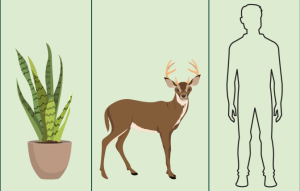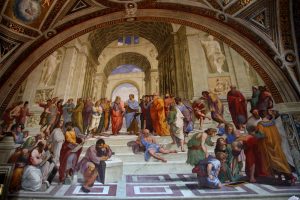17 Plato & Aristotle
Plato, Aristotle, and Legacy
Thought Experiments
When philosophers want to clarify the relationship between concepts, they often consider hypothetical scenarios meant to isolate one or more features of a concept and place it in the appropriate relationship with other concepts. Such hypothetical scenarios are called thought experiments. These imaginative scenarios allow us to test or compare concepts to better understand their connections and logical consequences. Philosophers have used thought experiments for as long as we have a written record of philosophical thought. For instance, Plato devised an elaborate thought experiment in The Republic, in which he depicts Socrates and several of his friends describing an ideal city. The premise of this thought experiment is that if the philosophers could describe an ideal city in detail, they would be able to identify which part of the city gives rise to justice.
Aristotle, a Greek philosopher who followed Plato, arrives at the famous claim that “nature abhors a vacuum” (i.e., nature would not allow empty space between matter) by constructing a thought experiment. To argue for this conclusion, Aristotle assumes that there is such a void and then asks, how could one know the distance between two points in a vacuum? If there is any distance between two points, Aristotle reasons, that distance would have to be the property of something. But, by hypothesis, there is nothing between the two points: it is a pure void. Aristotle bases his reasoning on the idea that it is impossible for properties to exist without something they are the property of. This argument reveals that Aristotle thinks distance is a property of matter. Accordingly, it is impossible to measure distance in a pure void. Therefore, Aristotle reasons, it is not possible for a void to exist because it would occupy a distance that has no measure. Puzzles like this one can prompt fruitful philosophical reflection. What do you think about it?
Plato and his successors were prone to mysticism. It was easy to translate the philosophical theory of the forms into a mystical doctrine in which the forms were known by the mind of God. Aristotle resisted this trend. At the center of Aristotle’s work was his doctrine of the four causes. He believed that the nature of any single thing could be understood by answering four basic questions: “What’s it made of?” (material cause), “What shape does it have?” (formal cause), “What agent gave it this form?” (efficient cause), and, finally, “What is its end goal?” (final cause). Not only can we explain the nature of anything by answering these four basic questions, we can also understand the nature of the universe. Aristotle’s universe is a closed system that is comprehensible to humanity because it is composed of these four causes. Each cause leads to another, until we get to the first cause or prime mover at the head of it all. Somewhat obscurely, Aristotle claims that this first cause is “thought thinking itself.”
It is important to understand Aristotle’s account of the soul. Unlike Plato, who held that the soul is an eternal substance that is reborn in various bodies, Aristotle has a functional conception of the soul. He defined the soul based upon what the soul does. In Aristotle’s understanding, all living things have souls. Plants have a vegetative soul that promotes growth and the exchange of nutrients. The animal soul, in addition to taking in nutrients and growing, experiences the world, desires things, and can move of its own volition. Added to these various functions in humans is the ability to reason.

Aristotle believed that all living beings had souls, but that the souls of various types of creatures differed in their abilities. The soul of a plant promotes growth and the exchange of nutrients. The animal soul allows for everything a plant can do, with the additional ability to desire things and move of its own volition. Only the human soul makes possible the ability to reason.
It is generally true to say that Plato tended to be more focused on the transcendental world of the forms while Aristotle and his followers were more focused on this worldly existence. They shared a belief that the universe was comprehensible and that reason should serve as a guide to ordering our lives.
The Allegory of the Cave
In Book VII of The Republic, Plato offered his allegory of the cave, which depicts prisoners who have mistaken shadows cast on the wall of the cave for real beings and therefore have mistaken illusion for truth. The prisoners have been imprisoned throughout their lives. They are chained in place and have been positioned so that they can only see shadows that are cast upon the wall in front of them. They have come to treat the shadows not as the reflections that they are, but as something real. In an unexpected plot twist, one prisoner escapes and reaches the cave entrance. There, for the first time, he sees the sun, the true source of light (knowledge). After adjusting to the overpowering light emanating from the sun, the prisoner realizes that a fire was causing objects to cast shadows on the cave wall. The shadows cast by the fire within the cave were reflections. He realized that the shadows are not actual being or truth; they were merely fading facsimiles of reality. The escaped prisoner, freed from the chains of his earlier captivity (metaphorically speaking), understands the true nature of being and truth. He returns to the cave to “free” his fellow captives, but his claim is rejected by those in chains.
Plato’s Notion of Substance and Form
“The Allegory of the Cave.” YouTube, uploaded by TED-ed, 17 Mar. 2015
The prisoners were mistaking shadows for that which was real. But shadows do not last. As soon as the source of light fades, the shadows too disappear. If we want to identify the really real, Plato argued, we need to go beyond mere shadows and try to find those beings whose reality is not temporary. The idea or form of a thing, unlike the material “shadow,” was not subject to atrophy and change.
To account for the fundamental whatness of a thing, Plato suggested an unchanging form or idea as the underlying and unchanging substance. As all things within a person’s reality are subject to change, Plato reasoned that the forms or unchanging basic realities concerning all things must not be located within this world. He therefore posited a realm in which change did not occur.
There is an intuitive appeal to Plato’s accounting of the real to forms. How else could we explain our ability to recognize a type of being given the sheer number of differences we will observe in the instances of a thing? We can make sense of dog, for example, because beyond the differences found among spaniels, poodles, and retrievers, there is a form of dog that accounts for knowing dog and being as dog.
Aristotle on Matter and Form
Aristotle, a student of Plato, disagreed with his teacher. If forms did exist, he challenged, then how could forms influence things? How could an immaterial form–which lacks matter—cause change to material entities? In addition, what about concepts that are not easily reducible to a simple meaning or idea? Aristotle noted that “good was said in many ways” (Ethics 1096a–b as found in Adamson 2016, 232). The reduction to a single form to identify the whatness for something works when the concept is simple but does not work when a wide ranging concept (such as “the good”) is considered. Aristotle agreed with the approach of isolating dog-ness as the essence, but through the study of specific instances or particulars. He encouraged natural observation of the entity in question and introduced the categories of species and genera.

Unlike Plato, Aristotle does not focus an otherworldly form or collection of forms. In his middle and later works, Aristotle explained substance through a composite of matter and form. Form, much like an idea a sculptor has in mind, is the unchanging purpose or whatness informing each particular or individual instance. In this case of a sculpture, the sculptor’s vision or idea was referred to as the formal cause. The marble would be the material cause. The ability and artistic skill of the sculptor was termed the efficient cause. The final cause reflected the purpose of the being, or the reason why the sculpture was made in the first place.
The attitudes of Plato and Aristotle are reflected in Figure 6.5. This section details the interaction between the two central characters in the oil-on-canvas painting. Plato is the subject displayed to the left of center, and Aristotle is the subject depicted to the right of center. Plato’s gesture toward the heavens with his right hand was the artist’s way of recognizing Plato’s theory of forms. For Plato, forms were immutable and the ultimate reality. Forms were supposed to exist outside of our earthly realm as the things we observe are subject to change. Aristotle’s gesture with his right hand was the artist’s representation of Aristotle’s stressing of the form embedded within particular matter. The ultimate reality was supposed to be within each instance of matter observed. The material components were subject to change, but the form was not.
What do you think? The crucial difference introduced at this historical point was the emphasis placed upon particulars, individual instances of an entity, by Aristotle. While Plato stressed forms and asserted that there could be no individual instance without the form, Aristotle stressed particulars and asserted that without individual instances, there could be no knowledge of the form. Whereas Plato holds that beauty itself causes the beauty we see in flowers or faces, Aristotle asserts that there is no such thing as beauty without beautiful things, such as flowers and faces (Adamson 231)
Adapted from Introduction to Philosophy by Nathan Smith is licensed CC BY 4.0.
“Plato and Aristotle: Crash Course History of Science #3.” YouTube, uploaded by Crash Course, 16 Apr. 2018.
